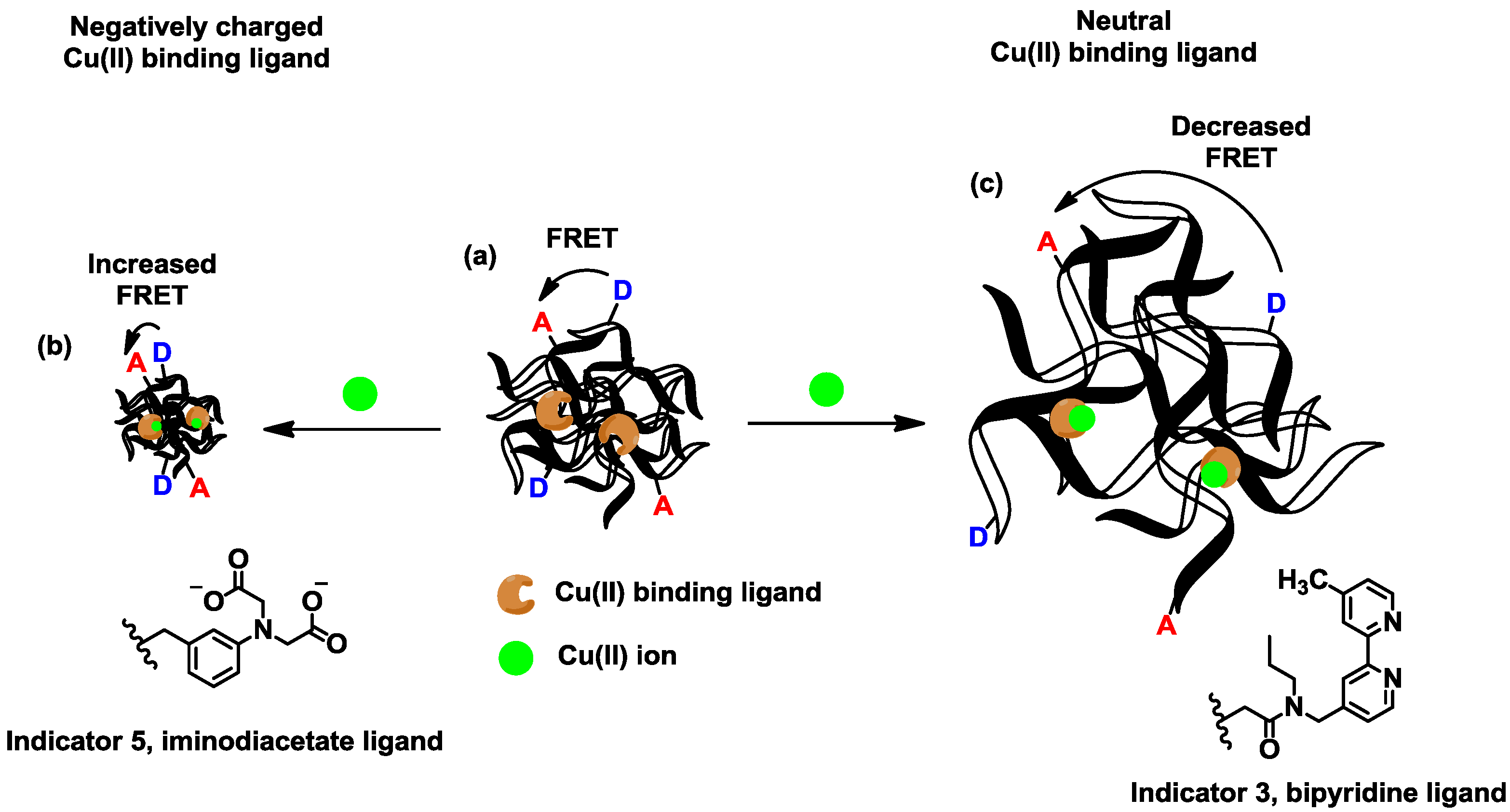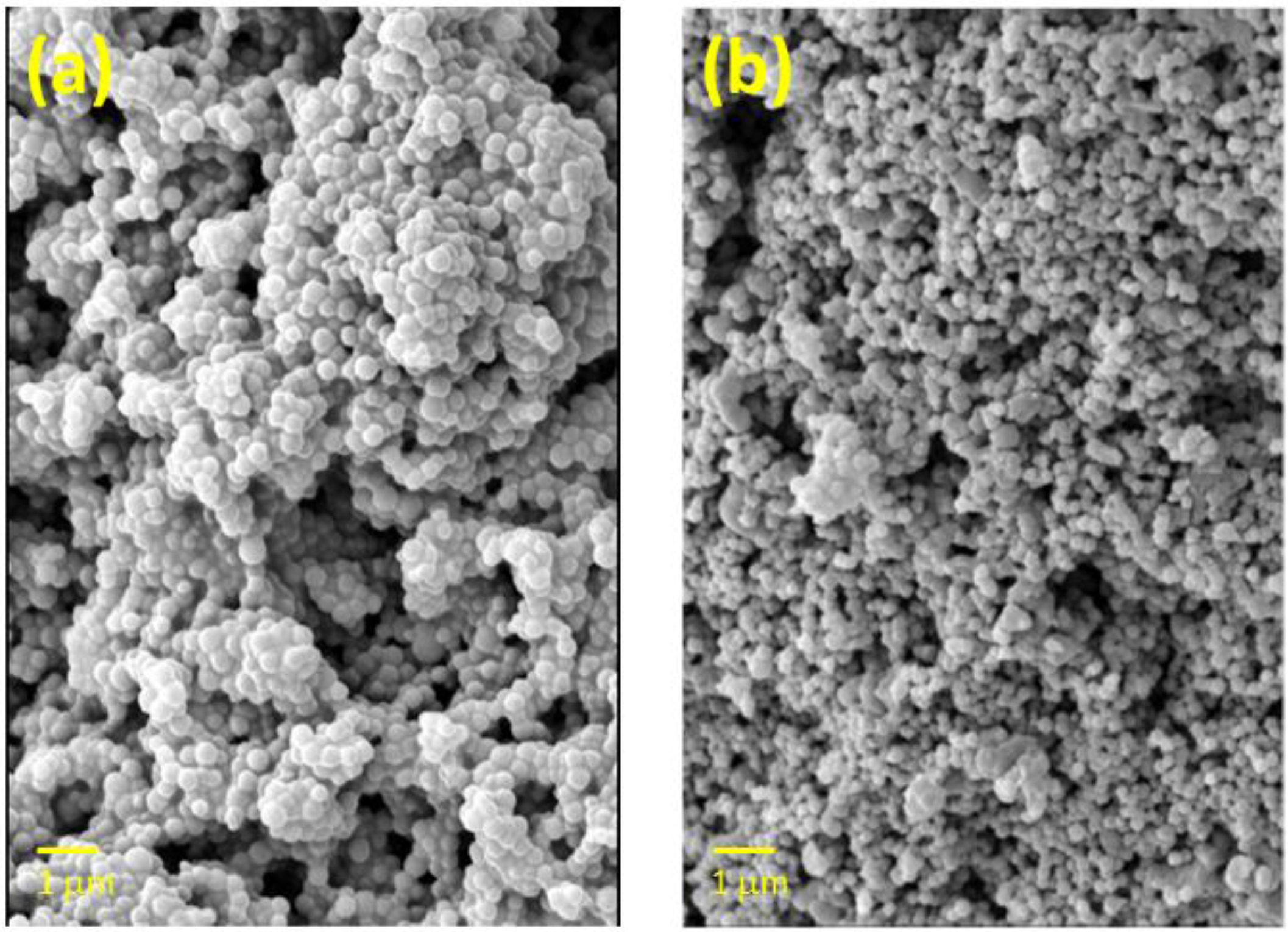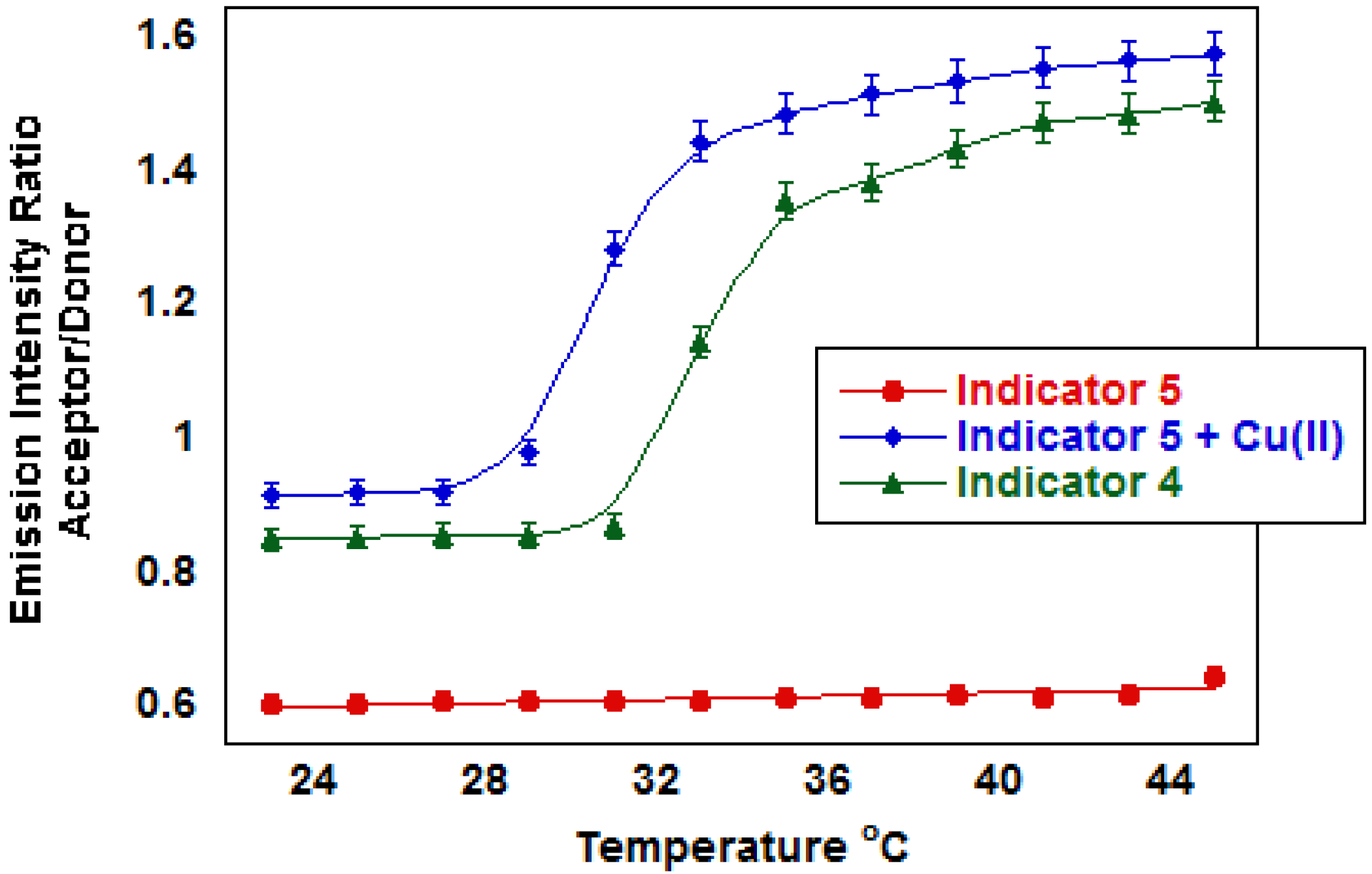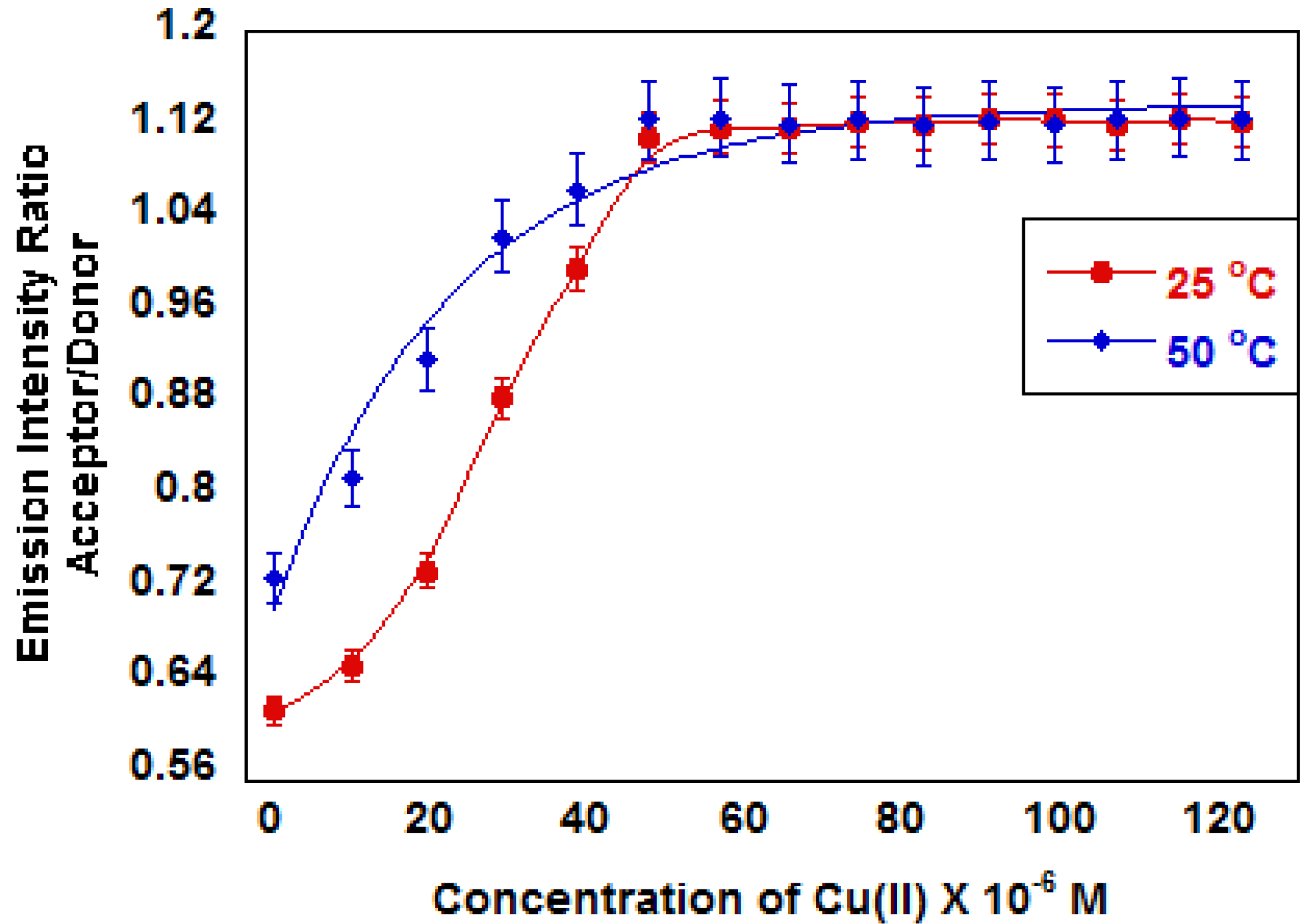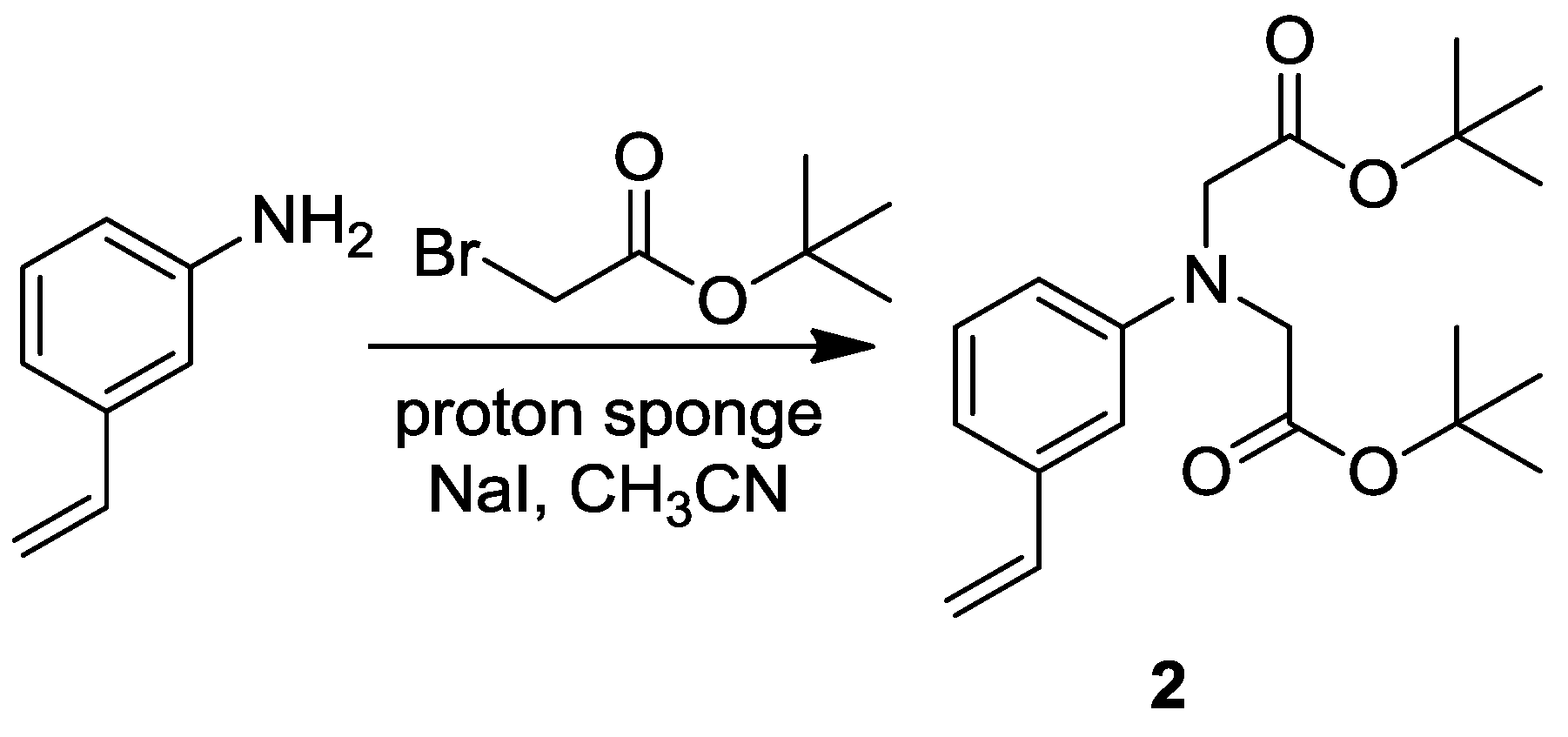1. Introduction
The effects of metal ions in biological and environmental systems depend on thermodynamic activity rather than total concentration [
1]. For example, Cu(II) toxicity varies over an order of magnitude depending on its degree of complexation with organic matter and competition with other metal ions for binding sites on aquatic organisms [
2,
3]. The biotic ligand model corrects for these effects and predicts Cu(II) toxicity better than total copper measurements [
2,
3].
While few techniques measure the thermodynamic activity of a metal ion directly, indicators provide a convenient method to quantify this property. Metal ion binding to a ligand (receptor) in an indicator induces measurable changes in the optical properties of a reporting group that may or may not be connected to the ligand. To prevent perturbing the metal ion activity, indicator concentration must remain lower than the total metal ion concentration. The measurable range of analyte concentration for any indicator depends on the receptor's affinity for the metal ion of interest, and is defined as log Kf − 1 to log Kf +1, where Kf is the conditional formation constant for metal ion.
The high sensitivity of emission spectroscopy means indicators utilizing fluorescence can be employed at the lowest possible levels. Furthermore, ratiometric fluorescence indicators simplify signal calibration by monitoring changes at different emission wavelengths rather than the absolute intensity. By measuring the intensity ratio at two different wavelengths, the output remains independent of indicator concentration. Ratiometric indicators are essential for applications such as measuring intracellular metal ion activity where total indicator concentrations cannot be established accurately. Ratiometric fluorescent indicators have enabled researchers to study the biological role of Ca(II) [
4] and Zn(II) [
5]; however, designing ratiometric indicators for metal ions such as Cu(II) that quench fluorescence emission remains challenging.
We and others are developing fluorescent metal ion indicators based on the thermal phase transition of poly(
N-isopropylacrylamide) (polyNIPAM) [
6–
11]. PolyNIPAM undergoes a thermal phase transition at elevated temperatures, which leads to aggregation and precipitation [
12]. The temperature at which the phase transition occurs is defined as the lower critical solution temperature (LCST). Metal ion binding to a polymer-bound ligand can modulate LCSTs by either introducing or neutralizing charge on the macromolecular backbone. With a properly engineered polymer maintained at a specific temperature, metal ion binding can induce the polyNIPAM thermal phase transition. When fluorophores are included in the polyNIPAM formulation, the phase transition can be coupled to emission changes. An important advantage of this approach is that selectivity depends on the relative affinity of the ligand for different metal ions [
9], which implies that selectivity can be varied by using different ligands.
Ratiometric indicators can be designed using an environmentally sensitive fluorescent label [
7,
8,
10]. In order to get a ratiometric response, we employed a fluorophore that shifts emission wavelength as function of polarity; however, the indicator was sensitive to slight changes in temperature and required UV excitation [
6]. Alternatively, fluorescence resonance energy transfer (FRET) between pairs of fluorophores with specific photophysical properties can be employed to obtain a ratiometric response. Recently, we successfully coupled the thermal phase transition of polyNIPAM with FRET signaling to measure Cu(II) concentrations with an uncrosslinked polymer indicator, which is soluble below the LCST [
9]. While this study provides important proof-of-concept detection, a homogenous indicator cannot be reused and is not useful for continuous sensing.
In contrast to solution-based indicators, detection systems using a solid support such as microparticles can be recycled and readily integrated into continuous sensing devices [
13,
14]. Lightly cross-linked polyNIPAM microparticles containing dibenzo-18-crown-6 ligands labeled with a FRET pair responds to K
+[
11]. The charge introduced by K
+ binding causes microparticles to swell, which increases the average distance between the donor and acceptor fluorophores of the FRET pair. The emission ratio of acceptor to donor intensities can be used to calculate potassium ion activity. While this study represents a significant advance in indicator design, K
+ does not quench emission like Cu(II). Homogeneous polyNIPAM indicators can overcome the inherent quenching properties of Cu(II) [
6,
9]; however, there is no experimental evidence to suggest the same effects are possible in a microparticle where molecular motion is more restricted. In addition to photophysical considerations, the K
+ indicator only examines introduction of charge onto the polymer backbone and does not address a charge neutralization mechanism, which would cause microparticles to collapse.
3. Results and Discussion
In earlier studies, the thermal phase transition properties of polyNIPAM were applied successfully to the design of homogeneous ratiometric indicators for Cu(II) [
6,
9]. These indicators exploit temperature-induced polymer architecture changes in the signal transduction mechanism. Below the LCST of 32 °C, pure polyNIPAM remains soluble in water because of hydrogen bonding between water and the amide groups; however, the polymer collapses and precipitates from solution at higher temperatures when the hydrogen bonds are broken [
15]. By including a Cu(II)-binding ligand and a fluorophore pair capable of undergoing FRET in the polymer formulation, the aggregation/disaggregation can be coupled to fluorescence ratio changes by shifting the LCST.
FRET involves distance-dependent transfer of excitation energy between a donor and acceptor fluorophore. When the donor and acceptor are in close proximity, excitation of the donor fluorophore leads to fluorescence characteristic of the acceptor. Alternatively, excitation of the donor fluorophore leads to donor-based emission if the FRET pair is separated in space. The ratio of donor emission to acceptor fluorescence correlates with the distance between the fluorophores, which depends on temperature in polyNIPAM. When Cu(II) binds to neutral ligands on the polyNIPAM, the additional charge-based hydrophilic interactions shift the LCST to higher temperatures; therefore, the decreased ratio of acceptor/donor emission correlates directly with Cu(II) concentration. Alternatively, a Cu(II)-binding negatively charged ligand will shift the LSCT to lower temperatures as the overall charge on the polymer backbone is neutralized making the macromolecule more hydrophobic, and the acceptor/donor emission ration increases.
Cross-linked polyNIPAM microparticles swell in water below the LCST and contract at higher temperatures (
Figure 1). As with uncrosslinked polyNIPAM, including comonomers in the formulation shifts the LCST of the polyNIPAM particles to lower or higher values depending on hydrophilic/hydrophobic interactions. A small percentage of a negatively charged monomer, like a carboxylate unit, can completely eliminate the phase transition resulting in microparticles that are swollen at all temperatures. Cu(II) binding to the ligands on the polymer backbone shifts the LCST by modifying the number of charges on the polymer backbone and induces swelling or shrinking. The temperature-dependent morphology changes cause the average distance between donor and acceptor fluorophores to increase or decrease, which changes the extent of FRET and therefore the emission ratio.
Copolymer microparticles were prepared by dispersion polymerization at 60 °C in CH
3CN using AIBN as the initiator and a styrene/acrylonitrile copolymer as a stabilizer. Indicator particles were obtained from polymeric formulations containing ca. 5 mol% ligand (
1 or
2), 5 mol% methylene-bisacrylamide cross-linker, 90 mol% NIPA, 0.2 mol% naphthalene methacrylate and 0.05 mol% VAN (
Figure 2). The microparticle diameter for indicator 1 ranges from 0.28 to 0.35 μm with an average diameter of 0.32 μm. Most indicator
2 microparticles have a diameter close to 0.15 μm but there is a subpopulation of larger microparticles. Bipyridine and phenyliminodiacetate were selected as the Cu(II)-binding ligands because of their well-studied coordination chemistry as well as their contrast in charge at neutral pH. The bipyridyl acrylate
1 was prepared as previously described [
9], and copolymerized with NIPA and fluorophores using the above formulation to make indicator
3. The phenyliminodiacetate was prepared as the
t-butyl ester
2 (
Scheme 1) and copolymerized with NIPA by the vinyl group. Treatment of the ester-containing polymer with acid provided the iminodiacetate containing indicator
5.
NMA and VAN were included in the polymer formulation as the FRET pair [
16], and were chosen because both monomers are commercially available and because xanthene-based fluorophores like rhodamine and fluorescein initiate radical polymerizations, which could lead to unwanted radical transfer and heterogeneity in microparticles [
17,
18]. To avoid complications in preparing the first generation indicators, the NMA and VAN fluorophore, which are compatible with free radical conditions, were ideal. Since the vinyl group of VAN reacts more rapidly than the acrylate of NMA, the VAN fluorophore will tend to localize near the center of the microparticles while the NMA will be distributed more evenly through the polymer. Fluorescence measurements involved exciting NMA at 260 nm, and measuring the ratio of VAN emission at 421 nm to NMA emission at 355 nm. While this FRET pair is convenient, the short excitation and emission wavelengths are subject to interference in many types of samples. Future efforts will be focused on labeling microparticles post-polymerization with fluorophores having excitation and emission in the visible region of the spectrum.
In the absence of a charged group, the emission ratio of FRET pair labeled polyNIPAM microparticles changes as a function to temperature. With excitation at 260 nm, emission from both NMA at 355 nm and VAN at 421 nm was observed. Since the absorption band of VAN minimally overlaps with the 260 nm excitation light, a significant fraction of the VAN emission arises from FRET from NMA. The emission intensity of both NMA and VAN decrease with increasing temperature in part because of thermal quenching. Some portion of the emission decrease may be due to particle settling that reduces the amount of polymer in the optical path; however, control experiments measuring second order scattered radiation suggest that settling occurs on the hour time scale and is not accompanied by a change in intensity ratio. The addition of Cu(II) at constant temperature caused a change in intensity ratio, but did not affect absolute intensities significantly, indicating little, if any, Cu(II) quenching.
While both the NMA and VAN emission intensities decrease, NMA decreases more significantly. As temperature increases, NMA excitation energy transfers to VAN through FRET (
Figure 3). The ratio changes from 0.92 at 25 °C to 1.6 at 35 °C. The LCST, estimated as the midway point of the change in ratio, occurs at 30 °C. The indicator LSCT is ∼2 °C below the LCST for unmodified polyNIPAM, which shows the impact of VAN, NMA and other hydrophobic monomers. The emission intensity ratio also changes over a wider range of temperature than unmodified polyNIPAM, which suggests the cross-linker introduces polymer heterogeneities that broaden the thermal phase transition. For comparison, the emission ratio remains unchanged over the same temperature range for indicator
5, which contains negatively charged groups. When Cu(II) neutralizes the charge carried on indicator
5, the emission ratio changes are similar to the uncharged polymer.
In MOPS buffer at pH 6 indicator
3 exhibits intensity ratio changes characteristic of FRET upon the addition of Cu(II) (
Figure 4). Fluorescence experiments were carried out at pH 6.0 to prevent the formation of metal hydroxide complexes. The intensity ratio decreases with added Cu(II) up to ∼5 × 10
−5 M. Above this concentration, the intensity ratio remains constant. The measured endpoint correlates closely with a 1:1 complex based on the calculated ligand concentration in the microparticles. The intensity ratio changes at both 25 °C and 50 °C, but more significantly at 50 °C. The decrease in acceptor emission, which indicates a decrease in FRET, is consistent with the microparticles swelling due to the introduction of charge by Cu(II) binding to the polymer backbone.
In indicator
5 containing the negatively charged iminodiacetate ligand, the emission intensity ratio increases as Cu(II) concentrations increase at both 25 °C and 50 °C (
Figure 5). At pH 6.0 where both carboxyl groups are deprotonated, the polyNIPAM microparticles swell due to the charges on the polymer, and no thermal phase transition was observed up to 50 °C. Addition of Cu(II) restores the thermal phase transition as charge neutralization causes the particles to contract increasing FRET. Indicator
4 where the carboxylate groups are protected by ester groups exhibits thermal phase transition behavior similar to the microparticles containing no ligand (LCST ∼30 °C). The Cu(II) complex of indicator
5 exhibits less hydrophobicity than indicator
4 as illustrated by the 33 °C LCST.
When indicator
3 was titrated with Cu(II) using an ion selective electrode, the titration endpoint suggests a bipyridine ligand content of 84% of the nominal concentration calculated from the initial formulation. The formation constant was determined to be 2.6 × 10
7 M, consistent with the literature value of 1.0 × 10
8 for the 1:1 complex of Cu(II) and bipyridine. The working range of any metal ion indicator is pM = log K
f ± 1, so the microparticles can detect Cu(II) activities between 4 × 10
−9 and 4 × 10
−7 M. Outside this range the change in intensity ratio will be too small to detect with adequate precision. Experiments with the ion selective electrode and indicator
5 indicate a ligand content of 88% based on initial formulation, and an 8.4 × 10
5 M formation constant for a 1:1 complex, which is close to the theoretical value of 2.5 × 10
6. This indicator will measure Cu activities from 1.2 × 10
−7 to 1.2 × 10
−5 M. The affinity data is consistent with the values obtained for the corresponding homogeneous, linear indicators [
9] so the microparticle systems should have similar selectivity for Cu(II), which is independent of the macromolecule and based primarily on the Irving-Williams series. For this proof-of-concept system, the lack of readily available ion selective electrodes precludes proving absolute formation constants for every possible competing metal ion. Our studies suggest that when the optimal Cu(II)-selective ligand becomes available, integrating it into either a homogeneous linear polymer or a microparticle will provide an indicator suitable for the desired applications [
6,
9].
The data in
Figures 4 and
5 include measurements above and below the polyNIPAM LCST. The fluorescence ratio change is larger below the LCST, which suggests that the responses are based on charge-induced polymer swelling. Detection limits for a given indicator will depend on the metal ion-indicator formation constant and our ability to measure fluorescence from a microparticle suspension. The data in
Figure 4 show a measurable ratio change for less than 1 μM metal ion using indicator
3. The data in
Figure 5 show a measurable ratio change for concentrations on the order of 1 μM.
